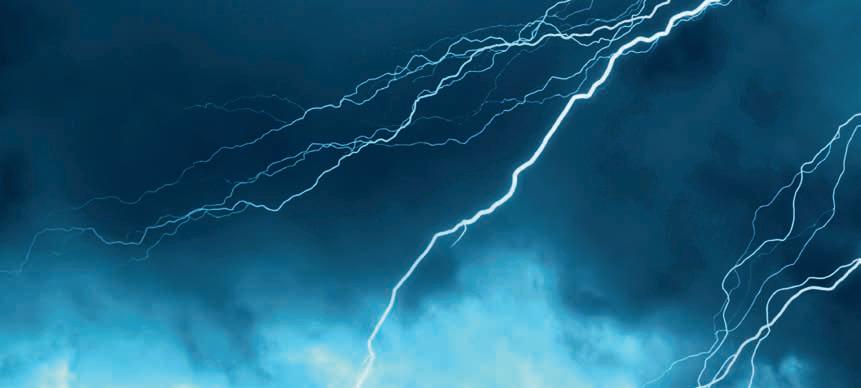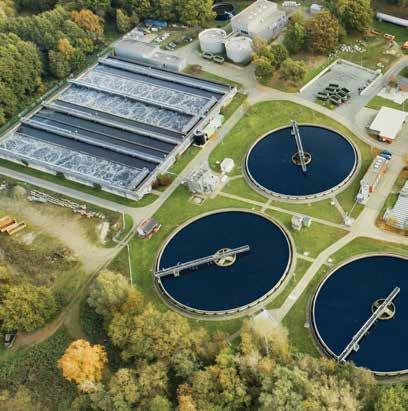
5 minute read
Weathering any storm
Following its primary objective of water protection, Abwasser, Grün und Lüneburger Service GmbH (AGL) has been increasingly focusing on achieving climate neutrality as the main task of its wastewater treatment operations. Within this context, the “Optimisation of aeration system and compressed air generation” project was created. For the latter, the operator wanted a solution that generates stable air in the event of weather fluctuations and that can be elegantly controlled. The use of four HBS rotary screw blowers successfully delivered the desired results, together with significant energy cost savings.

A bird's eye view of the Luneburg wastewater treatment plant
When taking a tour of the wastewater treatment plant, an illuminated panel catches the eye: electricity and heat are generated at the plant’s own combined heat and power plant. Accurate to the minute, the panel displays the current values, in large red digits, of the energy produced from the wastewater sludge. Due to co-fermentation, the energy yield is very high, since this sludge also contains fats resulting from fat separation of local restaurants and households in Lüneburg. The heat is mostly used to heat the wastewater sludge, while a smaller portion is used to heat the plant’s operations facilities. However, the situation is even more interesting when it comes to electricity generation: the combined heat and power plant generates approximately 6 million kWh of electricity per year. The plant’s own consumption is significantly lower, at up to 5 million kWh, so currently approximately 1 million kWh is fed into the local power grid. Yet, there are more plans in store for the electricity generated here, with the intended future goal of further expanding electric mobility at the site.

The illuminated panel shows the current values of the energy produced from the wastewater sludge.
Time for improvement
Within the framework of the climate protection project, the entire aeration process, including control valves and compressed air generation, was renewed and optimised. Prior to modernisation of the system, the air for the aeration tank was generated by four older 200-kW turbo compressors. In certain circumstances, such as under the influence of low-pressure atmospheric conditions or thunderstorms, these systems were often sensitive and prone to malfunction.
The operator therefore sought a solution that would control air generation more directly, dynamically and over a broader range, and which would achieve more consistent air intake performance regardless of extreme weather conditions. Furthermore, the energy consumption of the 25-year-old turbo compressors was no longer state-of-the-art in terms of efficiency. The modernisation project began in earnest with comprehensive planning and subsequent public tender.
Around that time, the IFAT trade fair was taking place in Munich. Master Electrician Christian Willenbockel recalls: “To generally inform ourselves regarding the technical possibilities, we had visited the KAESER stand at IFAT 2018 in Munich and saw an HBS rotary screw blower with controller. We weren’t yet sure if newer-generation turbo blowers, or modern rotary screw blowers would be the right solution to meet our needs. When we heard that KAESER was looking for companies to test out their new rotary screw blowers, we jumped at the opportunity to find out.” The KAESER system was commissioned in February 2019 and would demonstrate during a one-year test phase whether it was the right choice for the Lüneburg wastewater treatment plant’s requirements. The software for the master control technology was even reprogrammed and adapted to make this possible. The result was more than satisfactory, as the measured and documented values clearly showed. Christian Willenbockel happily explains: “The new rotary screw blower has precisely maintained the desired process values even in extreme weather conditions.”
Over the course of the formal procurement process, it was ultimately found that rotary screw blowers were best suited to fulfil the Lüneburg wastewater treatment plant’s requirements and that they provided the most economical solution. Therefore, in 2020 the decision was made to switch the entire station over to rotary screw blowers from KAESER: since then, two HBS 1600 M SFC (160 kW) and two HBS 1600 M SFC (200 kW) with frequency drive and Super Premium Efficiency motors have been responsible for aeration of the aeration tank. The decision was also made to choose the SIGMA AIR MANAGER master controller, as further tests have shown that it ensures even better system controllability.

The four HBS rotary screw blowers from KAESER.
Objective achieved
In addition to improved process control, significant energy savings were also verified. “The considerable cost savings that we have been able to record since the switchover are attributed to several factors: the impressive energy efficiency of the new blower systems, the decision to use a master controller and the reduction in system pressure from 710 mbar to 680 mbar, which we were able to achieve as a result of modernising the aeration system,” explains Jörg Schwanke, Laboratory Manager, contentedly. Ultimately, the sum of all measures resulted in savings of approximately 500,000 kWh per year, making this capacity available for other consumers, such as for the expansion of on-site electric mobility.








